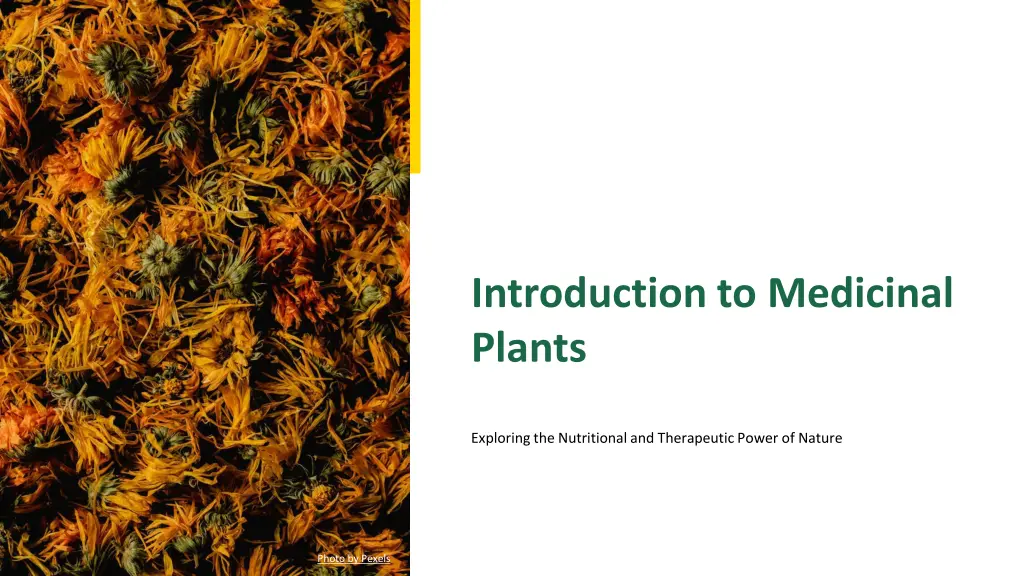
Exploring the Power of Medicinal Plants for Health and Wellness
Discover the nutritional and therapeutic benefits of medicinal plants, their bioactive compounds, and sustainable use. Learn about their cultural significance, safety considerations, and conservation practices for a holistic approach to herbal medicine.
Download Presentation

Please find below an Image/Link to download the presentation.
The content on the website is provided AS IS for your information and personal use only. It may not be sold, licensed, or shared on other websites without obtaining consent from the author. If you encounter any issues during the download, it is possible that the publisher has removed the file from their server.
You are allowed to download the files provided on this website for personal or commercial use, subject to the condition that they are used lawfully. All files are the property of their respective owners.
The content on the website is provided AS IS for your information and personal use only. It may not be sold, licensed, or shared on other websites without obtaining consent from the author.
E N D
Presentation Transcript
Introduction to Medicinal Plants Exploring the Nutritional and Therapeutic Power of Nature Photo by Pexels
01 The World of Medicinal Plants Table of Contents 02 Bioactive Compounds 03 Nutritional Benefits 04 Therapeutic Applications 05 Safety and Efficacy 06 Sustainability and Conservation 07 Cultural Significance 08 Modern Research and Innovations 09 Economic Impact 10 Conclusion and Future Directions
1 The World of Medicinal Plants A Journey into Nature's Pharmacy Medicinal plants are plants or plant parts used for nutritional and therapeutic purposes. Known as herbal, botanical, or phytomedicines, these plants promote health and treat diseases. Includes roots, stems, leaves, bark, seeds, fruits, and flowers. Used for centuries in various cultures for healing and wellness. Photo by Pexels
2 Bioactive Compounds Nature's Chemical Arsenal Compounds in plants that have effects on living organisms. These compounds can treat diseases and improve health. A wide range of chemical compounds with various health benefits. Ongoing studies to discover new medicinal uses. Photo by Pexels
3 Nutritional Benefits More Than Just Medicine Rich source of essential nutrients. Help in fighting free radicals and preventingdiseases. Supports digestive health and well-being. Contributes to overall health beyond just treating ailments. Photo by Pexels
4 Therapeutic Applications Healing Through Nature Used to treat colds, flu, digestive issues, and more. Potential in managing diabetes, hypertension, and arthritis. Some plants aid in reducingstress and anxiety. Used in skincare for their healing properties. Photo by Pexels
5 Safety and Efficacy Ensuring Safe Use Importance of correctly identifying medicinal plants. Guidelines for safe and effective use. Awareness of possible adverse reactions. Importance of seeking professional advice. Photo by Pexels
6 Sustainability and Conservation Protecting Our Natural Resources Overharvesting and habitatdestruction. Initiatives to protect and preserve plant species. Practices to ensure long-term availability. Involving local communities in conservation. Photo by Pexels
7 Cultural Significance Medicinal Plants in Tradition Integral part of many cultural traditions. Passed down throughgenerations. Used in various cultural rituals and practices. Impact on global health and wellness practices. Photo by Pexels
8 Modern Research and Innovations Bridging Tradition and Science Research validating traditional uses. New ways to use medicinal plants in modern medicine. Advancements in plant-based drug development. Potential for new discoveries and applications. Photo by Pexels
9 Economic Impact The Business of Medicinal Plants Growing demand for herbal products. Impact on local communities and economies. International trade of medicinal plant products. Potential for growth in the herbal industry. Photo by Pexels
10 Conclusion and Future Directions Embracing Nature's Gifts Recap of the nutritionaland therapeutic advantages. Addressing issues of sustainability and safety. Encouraging responsible use and conservation. Hopes for continuedresearch and discovery. Photo by Pexels
